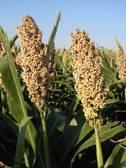U.S. grain sorghum meets all the specifications on the books to be competitive in Colombia except one: import tariffs.
“Import tariffs automatically put the United States at a competitive disadvantage. Sorghum from Argentina gets a 60 percent discount on the tariff since both Argentina and Colombia are parties to the Mercosur trade agreement,� said Troy Skarke of the United Sorghum Checkoff Program. Skarke and Chris Corry, U.S. Grains Council senior director of international operations, were in Colombia last week assessing the market potential for U.S. sorghum in the country.
Outside the tariff, Skarke said U.S. sorghum is within the 13.5 percent maximum moisture requirement Colombia specifies on imports. Since U.S. sorghum is also free of tannin, it would easily satisfy Colombia’s requirement that limits tannin content to 1 percent or less.
“When importers learned U.S. sorghum is tannin-free, they were very interested. Sorghum from Argentina, which fulfills the majority of their sorghum needs, generally contains more tannin than they specify,� he said. “Tannin content certainly would be factored into their buying decision.�
As for sorghum itself, Colombian importers and feed manufacturers like it for its storability and resistance to breakage. Importers also understand that tannin-free sorghum is virtually equal to corn in terms of market and feed value.
Sorghum sales to Colombia may also create opportunities for corn, distiller’s dried grains with solubles (DDGS) or gluten feed. Corry explained that importers would likely take a partial shipload of U.S. sorghum at a time but then fill the ship with other U.S. feed grains.
Should the U.S.-Colombia Trade Promotion Agreement (CTPA) be finalized, a tariff rate quota would allow 21,000 tons (827,000 bushels) of U.S. sorghum to come into Colombia tariff-free. After that, U.S. sorghum would be subject to the prevailing import duty, which can change every two weeks.
However, Corry noted that Colombia is part of the Andean Community, a trade bloc that also includes Bolivia, Ecuador and Peru. That trade bloc sets import duties. Since the United States already has a free trade agreement with Peru, it is unclear if the ANDEAN bloc would continue to exist or set import duties should CTPA go through.
“Free trade agreements take precedence over other trade agreements that Colombia and Peru have in place, so the unknown factor down the road could be whether and how import duties are set,� Corry said. “We may not know, of course, until CTPA is finalized, so that remains a priority; especially since the lack of a trade agreement has cost the United States millions of dollars in lost sales.�
Corry noted that 99 percent of everything Colombia exports to the United States already comes in duty-free. “We’re only hurting ourselves by not having the CTPA in place,� he said. “The CPTA would provide opportunities for U.S. sorghum, certainly, but also corn, DDGS and other ag products from the United States, including cotton.�


